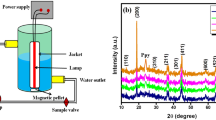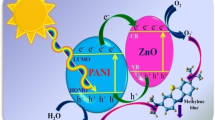Abstract
Conductive polymers perform as a new class of very active photocatalysts under visible light. Among them, polypyrrole (PPy) is one of the most promising conjugated polymers with a wide range of applications. PPy and doped PPy were synthesized on glass plate in thin film form by a facile simple successive ionic layer adsorption and reaction method. Polypyrrole is doped with dodecyl benzene sulphonic acid, toluene sulphonic acid, hydrochloric acid, sodium iodide (NaI), citric acid (commercial) and citric acid (lemon). The synthesized thin film was well characterized using UV–visible spectrophotometer, scanning electron microscopy, Fourier transform infrared spectroscopy, thermogravimetric analysis and photoluminescence (PL). The electrical conductivity was measured by Hall effect measurements. Among various organic and inorganic acid dopants, NaI-doped PPy thin film exhibited narrow band gap and has excellent ability to absorb light in red region of the spectrum. NaI-doped PPy thin film showed higher conductivity when compared to other dopants. A lower PL intensity of NaI-PPy thin film indicates higher electron–hole pair separation efficiency. The photocatalytic activities of PPy thin film and NaI-doped PPy thin film on rhodamine 6G dye under visible light were systematically investigated. NaI-doped PPy thin film had better degradation efficiency than PPy due to its higher electron–hole pair separation efficiency.












Similar content being viewed by others
References
Chu S, Majumdar A (2012) Opportunities and challenges for a sustainable energy future. Nature 488:294–303
Chen X, Li C, Grätzel M, Kostecki R, Mao SS (2012) Nanomaterials for renewable energy production and storage. Chem Soc Rev 41:7909–7937
Zhang Q, Uchaker E, Candelaria SL, Cao G (2013) Nanomaterials for energy conversion and storage. Chem Soc Rev 42:3127–3171
Asahi R, Morikawa T, Ohwaki T, Aoki K, Taga Y (2001) Visible-light photocatalysis in nitrogen-doped titanium oxides. Science 293:269–271
Schneider J, Matsuoka M, Takeuch M, Zhang J, Horiuchi Y, Anpo M, Bahnemann D (2014) Understanding TiO2 photocatalysis: mechanisms and materials. J Chem Rev 114:9919–9986
Xu X, Randorn C, Efstathiou P, Irvine JTS (2012) A red metallic oxide photocatalyst. Nat Mater 11:595–598
Liu L, Ouyang S, Ye J (2013) Gold-nanorod-photosensitized titanium dioxide with wide-range visible-light harvesting based on localized surface plasmon resonance. Angew Chem Int Ed 52:6689–6694
Zhang N, Zhang Y, Xu J (2012) Recent progress on graphene-based photocatalysts: current status and future perspectives. Nanoscale 4:5792–5813
Li L, Yan J, Wang T, Zhao Z, Zhang J, Gong J, Guan N (2015) Sub-10 nm rutile titanium dioxide nanoparticles for efficient visible-light-driven photocatalytic hydrogen production. Nat Commun 6:5881–5891
Tao J, Luttrell T, Batzill M (2011) A two-dimensional phase of TiO2 with a reduced bandgap. Nat Chem 3:296–300
Chen XB, Liu L, Yu PY, Mao SS (2011) Increasing solar absorption for photocatalysis with black hydrogenated titanium dioxide nanocrystals. Science 331:746–750
Linic S, Christopher P, Ingram DB (2001) Plasmonic-metal nanostructures for efficient conversion of solar to chemical energy. Nat Mater 10:911–921
Weng L, Zhang H, Govorov AO, Ouyang M (2014) Hierarchical synthesis of non-centrosymmetric hybrid nanostructures and enabled plasmon-driven photocatalysis. Nat Commun 5:4792–4802
Grabowska E, Zaleska A, Sorgues S, Kunst M, Etcheberry A, Colbeau-Justin C, Remita H (2013) Modification of titanium(IV) dioxide with small silver nanoparticles: application in photocatalysis. J Phys Chem C 117:1955–1962
Hai Z, Kolli N, Uribe D, Beaunier P, Yacaman M, Vigneron J, Etcheberry A, Sorgues S, Justin C, Chen J, Remita H (2013) Modification of TiO2 by bimetallic Au–Cu nanoparticles for wastewater treatment. J Mater Chem A 1:10829–10836
Kowalska E, Yoshiiri K, Wei Z, Zheng S, Kastl E, Remita H, Ohtani B, Rau S (2015) Hybrid photocatalysts composed of titania modified with plasmonic nanoparticles and ruthenium complexes for decomposition of organic compounds. Appl Catal B Environ 178:133–143
Naik GV, Shalaev VM, Boltasseva A (2013) Alternative plasmonic materials: beyond gold and silver. Adv Mater 25:3264–3294
Ghosh S, Kouame N, Remita S, Goubard F, Aubert P, Dazzi A, Besseau A, Remita H (2015) Conducting polymer nanostructures for photocatalysis under visible light. Nat Mater 14:505–510
Khodagholy T, Doublet P, Quilichini M, Gurfinkel P, Leleux A, Ghestem E, Ismailova T, Hervé S, Sanaur C Bernard, Malliaras G (2013) In vivo recordings of brain activity using organic transistors. Nat Commun 4:1575–1582
Li G, Shrotriya V, Huang J, Yao Y, Moriarty T, Emery K, Yang Yang (2005) High-efficiency solution processable polymer photovoltaic cells by self-organization of polymer blends. Nat Mater 4:864–868
Cai M, Ye Z, Xiao T, Liu R, Chen Y, Mayer R, Biswas R, Ho K, Shinar R, Shinar J (2012) Extremely efficient indium–tin-oxide-free green phosphorescent organic light-emitting diodes. Adv Mater 24:4337–4342
Muktha B, Madras G, Guru Row U, Patil S (2007) Conjugated polymers for photocatalysis. J Phys Chem B 111:7994–7998
Alam P, Alam A, Anwer MdK, Alqasoumi S (2014) Quantitative estimation of hesperidin by HPTLC in different varieties of citrus peels. Asian Pac J Trop Biomed 4(4):262–266
Rauf A, Uddin G, Ali J (2014) Phytochemical analysis and radical scavenging profile of juices of Citrus sinensis, Citrus anrantifolia, and Citrus limonum. Organ Med Chem Lett 4:5–8
Wang ZL, Kong XY, Ding Y, Gao P, Hughes WL, Yang R, Zhang Y (2004) Semiconducting and piezoelectric oxide nanostructures induced by polar surfaces. Adv Func Mater 14:943–956
Shiigi H, Kishimoto M, Yakabe H, Deore B, Nagaoka T (2002) Highly selective molecularly imprinted overoxidized polypyrrole colloids one-step preparation technique. Anal Sci 18:41–45
Song MK, Kim YT, Kim BS, Kim J, Char K, Rhee HW (2004) Synthesis and characterization of soluble polypyrrole doped with alkylbenzenesulfonic acids. Synth Met 141:315–319
Hazarika J, Kumar A (2016) Studies of structural, optical, dielectric relaxation and ac conductivity of different alkylbenzenesulfonic acids doped polypyrrole nanofibers. Physica B Condens Matter 481:268–279
Chen L, Wang K, Mahmoud SM, Li Y, Huang H et al (2015) Effects of replacing thiophene with 5,5-dimethylcyclopentadiene in alternating poly(phenylene), poly(3-hexylthiophene), and poly(fluorene) copolymer derivatives. Polym Chem 6:7533–7542
Navale ST, Mane AT, Ghanwat AA, Mulik AR, Patil VB (2014) Camphor sulfonic acid (CSA) doped polypyrrole (PPy) films: measurement of microstructural and optoelectronic properties. Measurement 50:363–369
Arora K, Chaubey A, Singhal R, Singh RP et al (2006) Application of electrochemically prepared polypyrrole-polyvinyl sulphonate films to DNA biosensor. Biosens Bioelectron 21:1777–1783
Wang G, NeoH KG, Kang ET (2004) Comparative study of chemically synthesized and plasma polymerized pyrrole and thiophene thin films. Thin Solid Films 446:205–217
Jayamurgan P, Ponnuswamy V, Ashokan S, Mahalingam T (2013) The effect of dopant on structural, thermal and morphological properties of DBSA-doped polypyrrole. Iran Polym J 22:219–225
Galář B, Dzurňák P, Malý J, Čermák A, Kromka M, Omastová B Rezek (2013) Chemical changes and photoluminescence properties of UV modified polypyrrole. Int J Electrochem Sci 8:57–70
Jang KS, Ko HC, Moon B, Lee H (2005) Observation of photoluminescence in polypyrrole micelles. Synth Met 150:127–131
Son AJR, Lee H, Moon B (2007) Morphology and photoluminescence of colloidal polypyrrole nanoparticles. Synth Met 157:597–602
Shaktawat V, Jain N, Saxena R, Saxena NS, Sharma TP (2006) Electrical conductivity and optical band gap studies of polypyrrole doped with different acids. Polym Bull 57:535–542
Naveen Kumar M, Nagabhooshanam M, Anand Rao M, Bhagvanth Rao M (2001) Preparation and characterization of doped polybenzidine. Cryst Res Technol 36:309–317
Khanmirzaei MH, Ramesh S, Ramesh K (2015) Effect of different iodide salts on ionic conductivity and structural and thermal behavior of rice-starch-based polymer electrolytes for dye-sensitized solar cell application. Ionics 21:2383–2391
Singh R, Baghel J, Shukla S, Bhattacharya B, Rhee H-W, Singh PK (2014) Detailed electrical measurements on sago starch biopolymer solid electrolyte. Phase Transit 87:1237–1245
Sirakawa H, Louis EJ, Macdiarmid AG, Chiang CK, Heegert AJ (1977) Synthesis of electrically conducting organic polymers: halogen derivatives of polyacetylene, (CH)x. J Chem Soc, Chem Commun 16:578–580
Mabrook MF, Pearson C, Petty MC (2006) Inkjet-printed polypyrrole thin films for vapour sensing. Sens Actuators, B 115:547–551
Tinacba EJC, Nuñez JA, Tumlos RB, Ramo HJ (2016) ZnO/Zn and ZnO film deposited via microwave atmospheric plasma jet as photo-catalyst for Rhodamine 6G dye degradation. Thin Solid Films. https://doi.org/10.1016/j.tsf.2016.07.01
Kansal SK, Singh M, Sud D (2007) Studies on photodegradation of two commercial dyes in aqueous phase using different photocatalysts. J Hazard Mater 141:581–590
Ghosh S, Kouame N, Remita S, Ramos L, Goubard F, Aubert P, Dazzi A, Deniset-Besseau A, Remita H (2015) Visible-light active conducting polymer nanostructures with superior photocatalytic activity. Sci Rep 5:18002–18011
Ovando-Medina VM, López RG, Castillo-Reyes BE, Alonso-Dávila PA, Martínez-Gutiérrez H, González-Ortega O, Farías-Cepeda L (2015) Composite of acicular rod-like ZnO nanoparticles and semiconducting polypyrrole photoactive under visible light irradiation for methylene blue dye photodegradation. Colloid Polym Sci 293:3459–3469
Montazerozohori M, Nasr-Esfahani M, Joohari S (2012) Iron and aluminium based adsorption strategies for removing arsenic from water. Environ Prot Eng 38:45–56
Acknowledgements
This work is mainly supported by the research funds from the management of Hindustan University through CENCON. Authors also acknowledge research funding from Dongguk University though QSRC and NITA. This research was also supported by Leading Foreign Institute Recruitment Program through the National Research Foundation of Korea (NRF) funded by the Ministry of Education Science and Technology (MEST) (No. 2013-044975) and by the International Research and Development Program of the National Research Foundation of Korea (NRF) funded by the Ministry of Education, Science and Technology (MEST) of Korea (Grant Number: 2012-033431).
Author information
Authors and Affiliations
Corresponding authors
Rights and permissions
About this article
Cite this article
Krishnaswamy, S., Ragupathi, V., Raman, S. et al. Study of optical and electrical property of NaI-doped PPy thin film with excellent photocatalytic property at visible light. Polym. Bull. 76, 5213–5231 (2019). https://doi.org/10.1007/s00289-018-2650-1
Received:
Revised:
Accepted:
Published:
Issue Date:
DOI: https://doi.org/10.1007/s00289-018-2650-1




